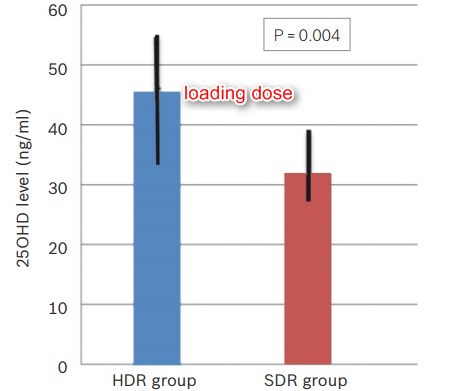Neonate loading dose of 30,000 IU vitamin D helped a lot
Comparison of two regimens of vitamin D supplementation for vitamin D-deficient neonates.
Singapore Med J. 2014 May;55(5):266-70.
Shakiba M1, Pahloosye A, Mirouliaei M, Islami Z.
INTRODUCTION:
Vitamin D deficiency is common in pregnant women, and supplementation of vitamin D is necessary for the infants of these women. This study explored the efficacy of an alternative way of vitamin D supplementation in an area with a high prevalence of vitamin D deficiency in mothers.
METHODS:
This was a non-randomised clinical trial conducted in 2010 in Yazd, Iran. Full-term healthy infants born to vitamin D-deficient mothers (n = 82) were divided into the high-dose regimen (HDR; single oral bolus 30,000 IU vitamin D3, n = 34) and the standard-dose regimen (SDR; 400 IU/day vitamin D3 within two weeks of life, n = 48) groups. 25-hydroxyvitamin D (25OHD) was measured using chemiluminescent immunoassays, and 25OHD level > 20 ng/mL was deemed sufficient.
RESULTS:
Over 90% of infants in the HDR group attained vitamin D sufficiency within one month, while comparable sufficiency was reached in the SDR group only after four months. At two months, the proportion of infants attaining 25OHD > 30 ng/mL was 93.3% and 27.9% in the HDR and SDR groups, respectively (p = 0.003). None of our infants achieved 25OHD levels > 100 ng/mL.
CONCLUSION:
For infants born to vitamin D-deficient mothers, oral supplementation of 30,000 IU vitamin D3 during the first month of life, followed by a routine recommended dose of 400 IU/day, should be considered. The four-month lag for attaining vitamin D sufficiency in 90% of infants in the SDR group may have clinical implications and should be further investigated.
PMID: 24862751
Virtually all infants with loading dose got > 30 ng

Loading dose group had much higher Vitamin D levels at 2 months

Note by Vitamin D Life: Mothers in Iran have very low levels of vitamin D. This large of a loading dose may not be needed elsewhere
See also Vitamin D Life
Third study found that Infants needed 1600 IU of vitamin D – JAMA RCT May 2013
Giving vitamin D to ALL children reduced (rickets) symptoms by 60 percent – Aug 2012
items in BOTH of categories: infants and loading dose
{category}
